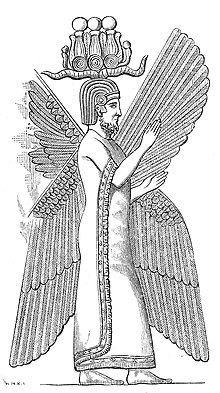Hemhem crown
| Hemhem | |
|---|---|
 The hemhem crown, based on depictions from antiquity | |
| Details | |
| Country | Ancient Egypt |

Hemhem crownwas anancient Egyptianceremonial headgear. The hemhem crown consisted of threeatefs(which may be called a triple atef[2]), twouraei,two ram's horns, and three to six solar disks. The first appearance of the hemhem crown is during the reign ofAkhenatenin the 14th century BC, appearing as an alternative to the atef crown, and it underwent development between the18thand21st dynasties.Gods likeHeka,[3]Isis,[4]andOsirisalso appeared with the hemhem crown, and during the Greco-Roman period, solar deities were also depicted wearing it in some temples.[5]
Later the hemhem crown was shown on the images of non-Egyptian rulers, such asNubiansNatakamani,ArnekhamaniorSilko of Nobadia.[6]A bas-relief atPasargadaedepicting a "Winged Figure" or "Winged Genius" with the hemhem crown indicates the proliferation of Egyptian paraphernalia.[2]This evidence indicates that the hemhem crown had passed into Iranian iconography, likely through an intermediary as opposed to directly from Egyptian sources, this being usually identified as North Syrian or Phoenician art[7]where it was commonly associated with divine beings.[8]
Etymology[edit]
TheEgyptianword "hemhem" means "to shout", "cry out", possibly indicating that the hemhem crown represented a battle horn or war cry,[6]although it was also donned on festive occasions.[9]
History[edit]
The hemhem crown was first seen in the18th Dynasty,and was worn during significant ceremonies. The symbolic interpretation behind this crown was to boast the power of the Pharaoh.[10]An early appearance of the hemhem crown was during the reign ofAkhenatenas seen in a relief fromhis tombatAmarna.[3]Tutankhamunwas depicted wearing the hemhem crown on the inlay of a throne found in his tomb.[10]This crown was often depicted on kings during thePtolemaic Dynasty.[11]
The crown was eventually transplanted into Syrian and Iran contexts, where it underwent further adaptations in light of the political needs of the time.[12]ThePasargadaefigure depicted with the hemhem crown has been variously associated with many figures. In the past, it was more common to identify the figure withCyrus the Great[13]but more recent work indicates that this is not the case[7][14]with identifications opting instead towards a god likeMithra[12]or something between a man and a god.[7][14]The depiction itself indicates the proliferation of Egyptian paraphernalia.[2]
Features[edit]

The crown is set on top of a pair of long spiral ram's horns, and it is commonly seen with a cobra on either side of the crown.[15]It was created with reeds and ostrich feathers, along with feathers from many other birds. The hemhem was theTriple Rush Crown,and was worn tilted towards the back of the head – contrary to how crowns are normally worn.[3]
Another type of hemhem crown has three falcon birds in place of the three sun disks. This type of crown signifies the reign over Lower Egypt; the combination of the sun disks and the falcon shows the power over Lower Egypt along with Upper Egypt. The hemhem crowns occur more frequently from the time ofPtolemy VIonwards. The symbols on the crown, such as reeds anduraeusessignify a later time period. The more intricate the carvings on the crown, the later the time period of the crown. Falcons and horn imagery are not part of the earlyPtolemaicperiod and are rarely depicted in hieroglyphs during that time period. Many other features of the crown, such as feathers from different animals, are all found in different time periods. Each feather added on the hemhem crown has significance to its time period. The form of the crown was constantly changing according to the time period; different items would be added on or taken off, or the shape of the crown would change. The crown was often depicted along with the nemes – the striped headcloth – and just as each time period had its significance, so did the collaboration of the nemes and the hemhem crown.[16]
See also[edit]
References[edit]
Citations[edit]
- ^Stronach & Gopnik 2009.
- ^abcGoebs 2013.
- ^abc(June, 2014) Crowns of Egypt.Land of Pyramids.Retrieved on 10/08/2014. Fromhttp:// landofpyramids.org/crown-of-egypt.htm
- ^Azzopardi 2023,p. 72–73.
- ^Ismail 2019,p. 49–51.
- ^abLobban 2003,p. 364.
- ^abcSekunda 2010,p. 268–271.
- ^Boyce 2015,p. 60.
- ^Vassilika 1989,p. 90.
- ^ab(n.d.) The Hemhem Crown.Arty Factory.Retrieved on 10/08/2014. fromhttp:// artyfactory /egyptian_art/egyptian_crowns/hemhem_crown.htmArchived2017-08-10 at theWayback Machine
- ^Reshafim, K. (n.d.) Divine and Royal headdresses and Crowns.Pharaonic Egypt.Retrieved on 10/08/2014. Fromhttp:// reshafim.org.il/ad/egypt/crowns/Archived2018-07-01 at theWayback Machine
- ^abSoudavar 2012,p. 49–52.
- ^Curzon 2018,p. 75.
- ^abStronach 2010,p. 6–9.
- ^(n.d.)Ancient Egyptian Crowns/Headdresses.Architecture Around the World.Retrieved on 10/08/2014. Fromhttp://buffaloah /a/archsty/egypt/crowns/crowns.html
- ^Vassilika 1989.
Sources[edit]
- Azzopardi, George (2023).The Roman Municipia of Malta and Gozo: The Epigraphic Evidence.Archaeopress Publishing Limited.ISBN978-1-80327-615-1.
- Boyce, Mary (2015).A History of Zoroastrianism, Zoroastrianism Under the Achaemenians: Volume 2.Brill.ISBN978-90-04-29390-8.
- Curzon, George Nathaniel (2018).Persia and the Persian Question, Volume 2.Cambridge University Press.ISBN978-1-108-08085-9.
- Goebs, Katja (2013)."Crowns, Egyptian".In Bagnall, Roger S.; Brodersen, Kai; Champion, Craig B.; Erskine, Andrew (eds.).The Encyclopedia of Ancient History.Wiley.
- Ismail, Fatma Talaat (2019).Cult and Ritual in Persian Period Egypt: An Analysis of the Decoration of the Cult Chapels of the Temple of Hibis at Kharga Oasis.Yale Egyptology.ISBN978-1-950343-11-9.
- Lobban, Christian A. (2003).Historical Dictionary of Ancient and Medieval Nubia.Scarecrow Press.ISBN978-0-8108-6578-5.
- Sekunda, N.V. (2010)."Changes in Achaemenid Royal Dress".In Curtis, John; Simpson, John (eds.).The World of Achaemenid Persia: History, Art and Society in Iran and the Ancient Near East.I.B. Tauris. pp. 255–272.ISBN978-0-85771-801-3.
- Soudavar, Abolala (2012)."Astyages, Cyrus and Zoroaster: Solving a Historical Dilemma".Iran.50(1): 45–78.doi:10.1080/05786967.2012.11834712.
- Stronach, David; Gopnik, Hilary (2009)."PASARGADAE".Encyclopedia Iranica.
- Stronach, David (2010)."Solomon at Pasargadae: Some New Perspectives".Bulletin of the Asia Institute.24:1–14.JSTOR43896116.
- Vassilika, Eleni (1989).Ptolemaic Philae.Peeters Publishers.ISBN978-90-6831-200-3.
Further reading[edit]
- David Stronach, Pasargadae: A Report on the Excavations Conducted by the British Institute of Persian Studies from 1961 to 1963: Volume 1, 1978.
- Sandra Collier,The Crowns of Pharaoh: Their Development and Significance in Ancient Egyptian Kingship,1996.

